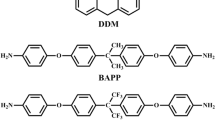Abstract
A comprehensive mechanical characterization of a commercially available hot curing epoxy system (Araldite® LY 564 with Aradur® 2954, HUNTSMAN Corp.) is performed including compression tests at quasi-static and high strain rates, as well as creep and relaxation tests. High strain rate tests (770/s and 875/s) are conducted by using a split-Hopkinson pressure bar (SHPB) apparatus and compared with the quasi-static compression tests at three strain rates (0.001/s; 0.01/s; 0.1/s). Elasticity modulus and yield stress increase with increasing strain rate, for both quasi-static and high strain rate conditions. The change in the mechanical behavior from quasi-static to high strain rate conditions is quite prominent. While strain rate changes from 0,001/s to 875/s, elasticity modulus increases from 1465 to 3193 MPa (118% increase) and yield stress from 119 to 204 MPa (72% increase). The evident exponential hardening at the viscoplastic region seen on quasi-static stress–strain curves is not observed at high strain rates. Creep tests are performed for three different stress levels (50, 100 and 200 MPa) and 120 min (7200 s). In addition, relaxation tests are done for three different strain levels (3.16, 7.15 and 35.5%) also for 120 min (7200 s). Creep compliance and relaxation modulus are calculated and plotted. It is observed that creep strain values at the stress levels lower than the yield point are lesser compared to creep strain values around yield strength since rate dependency is increasing with increasing stress. Creep at the hardening region is not prominent due to polymer chain entanglement. Stress drop during relaxation is increasing with the increasing strain level.













Similar content being viewed by others
References
** F-L, Li X, Park S-J (2015) Synthesis and application of epoxy resins: a review. J Ind Eng Chem 29:1–11. https://doi.org/10.1016/j.jiec.2015.03.026
Shadlou S, Ahmadi-Moghadam B, Taheri F (2014) The effect of strain-rate on the tensile and compressive behavior of graphene reinforced epoxy/nanocomposites. Mater Des 59:439–447. https://doi.org/10.1016/j.matdes.2014.03.020
Tamrakar S, Ganesh R, Sockalingam S et al (2018) Experimental investigation of strain rate and temperature dependent response of an epoxy resin undergoing large deformation. J Dyn Behav Mater 4:114–128. https://doi.org/10.1007/s40870-018-0144-8
Jordan JL, Foley JR, Siviour CR (2008) Mechanical properties of Epon 826/DEA epoxy. Mech Time-Depend Mater 12:249–272. https://doi.org/10.1007/s11043-008-9061-x
Colak ÖU, Bahlouli N, Uzunsoy D, Francart C (2020) High strain rate behavior of graphene-epoxy nanocomposites. Polym Test 81:106219. https://doi.org/10.1016/j.polymertesting.2019.106219
Goglio L, Peroni M, Rossetto M (2007) Effect of the strain rate on the mechanical behaviour of epoxy adhesives. Key Eng Mater 347:671–676. https://doi.org/10.4028/www.scientific.net/KEM.347.671
Gilat A, Goldberg RK, Roberts GD (2002) Experimental study of strain-rate-dependent behavior of carbon/epoxy composite. Compos Sci Technol 62:1469–1476. https://doi.org/10.1016/S0266-3538(02)00100-8
Tay TE, Ang HG, Shim VPW (1995) An empirical strain rate-dependent constitutive relationship for glass-fibre reinforced epoxy and pure epoxy. Compos Struct 33:201–210. https://doi.org/10.1016/0263-8223(95)00116-6
Littell JD, Ruggeri CR, Goldberg RK et al (2008) Measurement of epoxy resin tension, compression, and shear stress-strain curves over a wide range of strain rates using small test specimens. J Aerosp Eng 21:162–173. https://doi.org/10.1061/(ASCE)0893-1321(2008)21:3(162)
Mayr AE, Cook WD, Edward GH (1998) Yielding behaviour in model epoxy thermosets—I. Effect of strain rate and composition. Polymer 39:3719–3724. https://doi.org/10.1016/S0032-3861(97)10334-2
Li P, Petrinic N, Siviour CR et al (2009) Strain rate dependent compressive properties of glass microballoon epoxy syntactic foams. Mater Sci Eng A 515:19–25. https://doi.org/10.1016/j.msea.2009.02.015
Theocaris PS (1962) Viscoelastic properties of epoxy resins derived from creep and relaxation tests at different temperatures. Rheol Acta 2:92–96. https://doi.org/10.1007/BF01972534
Lee A, Mckenna GB (1998) Anomalous aging in two-phase systems: Creep and stress relaxation differences in rubber-toughened epoxies. J Polymer Sci Part I Polymer Phy 35:1167–1174. https://doi.org/10.1002/(SICI)1099-0488(199706)35:8<1167::AID-POLB1>3.0.CO;2-R
Ornaghi HL Jr, Neves RM, Monticeli FM, Almeida JHS Jr (2020) Viscoelastic characteristics of carbon fiber-reinforced epoxy filament wound laminates. Compos Commun 21:100418. https://doi.org/10.1016/j.coco.2020.100418
Almeida HS Jr, Ornaghi HL Jr, Amico SC (2017) Creep and interfacial behavior of carbon fiber reinforced epoxy filament wound laminates. Polym Compos 39:8. https://doi.org/10.1002/pc.24537
Almeida JH, Ornaghi HL, Lorandi N et al (2018) On creep, recovery, and stress relaxation of carbon fiber-reinforced epoxy filament wound composites. Polym Eng Sci 58:1837–1842. https://doi.org/10.1002/pen.24790
Nosrati N, Zabett A, Sahebian S (2020) Long-term creep behaviour of E-glass/epoxy composite: time-temperature superposition principle. Plast Rubber Compos 49:254–262. https://doi.org/10.1080/14658011.2020.1736867
Huntsman datasheet
Wang R-M, Zheng S-R, Zheng Y-P (2011) Polymer matrix composites and technology. Woodhead Publishing Limited, Sawston
Olowojoba GB, Eslava S, Gutierrez ES et al (2016) In situ thermally reduced graphene oxide/epoxy composites: thermal and mechanical properties. Appl Nanosci 6:1015–1022. https://doi.org/10.1007/s13204-016-0518-y
Wang F, Drzal LT, Qin Y, Huang Z (2015) Mechanical properties and thermal conductivity of graphene nanoplatelet/epoxy composites. J Mater Sci 50:1082–1093. https://doi.org/10.1007/s10853-014-8665-6
Kim J, Sholar GA, Kim S (2008) Determination of accurate creep compliance and relaxation modulus at a single temperature for viscoelastic solids. J Mater Civ Eng 20:147–156. https://doi.org/10.1061/(ASCE)0899-1561(2008)20:2(147)
Dusunceli N, Colak OU (2008) The effects of manufacturing techniques on viscoelastic and viscoplastic behavior of high density polyethylene (HDPE). Mater Des 29:1117–1124. https://doi.org/10.1016/j.matdes.2007.06.003
Acknowledgements
This work is supported by TUBİTAK (Project Number: 118M099).
Author information
Authors and Affiliations
Corresponding author
Additional information
Publisher's Note
Springer Nature remains neutral with regard to jurisdictional claims in published maps and institutional affiliations.
Rights and permissions
About this article
Cite this article
Bakbak, O., Birkan, B.E., Acar, A. et al. Mechanical characterization of Araldite LY 564 epoxy: creep, relaxation, quasi-static compression and high strain rate behaviors. Polym. Bull. 79, 2219–2235 (2022). https://doi.org/10.1007/s00289-021-03624-x
Received:
Revised:
Accepted:
Published:
Issue Date:
DOI: https://doi.org/10.1007/s00289-021-03624-x




